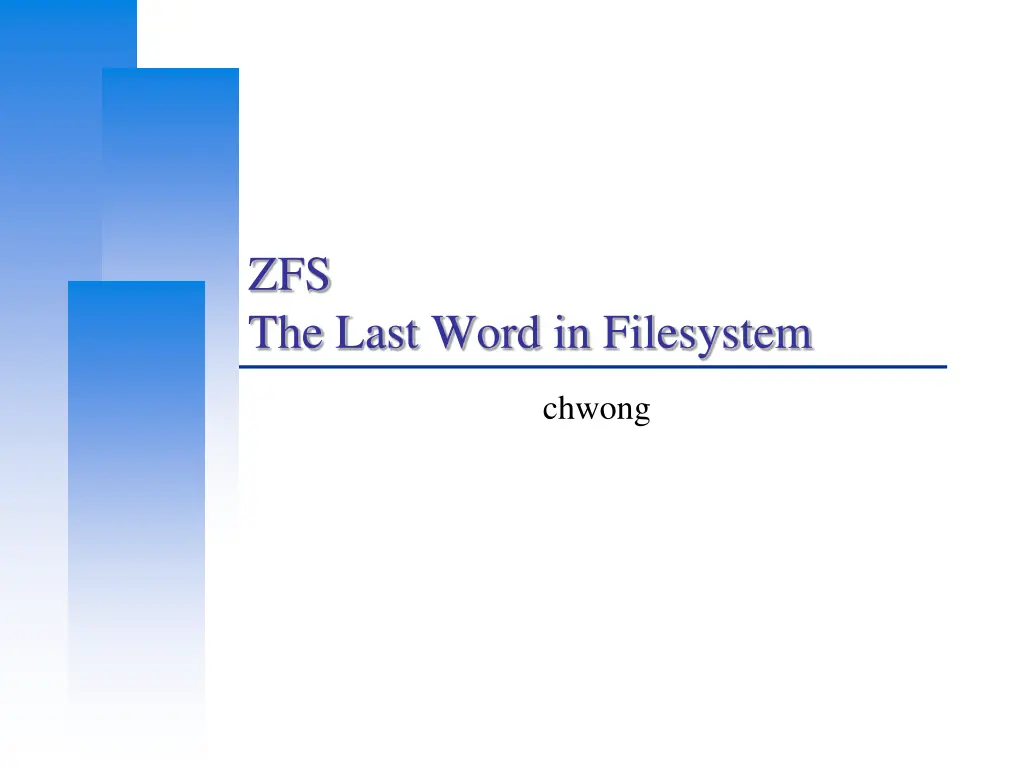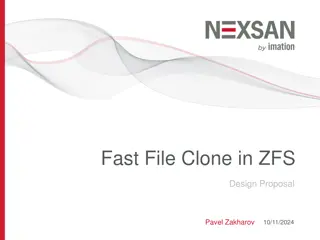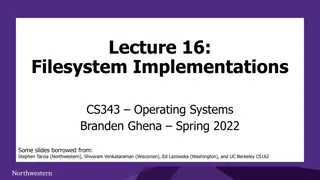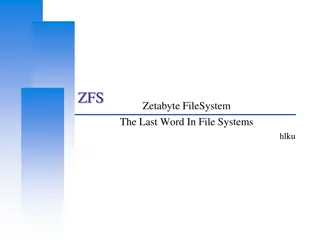
Understanding RAID: Types, Benefits, and Differences
Explore the world of RAID (Redundant Array of Independent Disks) technology with this detailed guide. Learn about various RAID types such as RAID 0, RAID 1, RAID 5, RAID 6, and RAID 10, their features, pros and cons, and how they can benefit your data storage needs. Whether you're a beginner or an enthusiast, this comprehensive overview will help you grasp the essentials of RAID configurations and make informed decisions for your storage solutions.
Uploaded on | 3 Views
Download Presentation

Please find below an Image/Link to download the presentation.
The content on the website is provided AS IS for your information and personal use only. It may not be sold, licensed, or shared on other websites without obtaining consent from the author. If you encounter any issues during the download, it is possible that the publisher has removed the file from their server.
You are allowed to download the files provided on this website for personal or commercial use, subject to the condition that they are used lawfully. All files are the property of their respective owners.
The content on the website is provided AS IS for your information and personal use only. It may not be sold, licensed, or shared on other websites without obtaining consent from the author.
E N D
Presentation Transcript
ZFS The Last Word in Filesystem chwong
Computer Center, CS, NCTU What is RAID? 2
Computer Center, CS, NCTU RAID Redundant Array of Independent Disks A group of drives glue into one 3
Computer Center, CS, NCTU Common RAID types JBOD RAID 0 RAID 1 RAID 5 RAID 6 RAID 10? RAID 50? RAID 60? 4
Computer Center, CS, NCTU JBOD (Just a Bunch Of Disks) 5 http://www.mydiskmanager.com/wp-content/uploads/2013/10/JBOD.png
Computer Center, CS, NCTU RAID 0 (Stripe) 6 http://www.intel.com/support/tw/chipsets/imsm/sb/cs-009337.htm
Computer Center, CS, NCTU RAID 0 (Stripe) Striping data onto multiple devices 2X Write/Read Speed Data corrupt if ANY of the device fail 7 http://www.intel.com/support/tw/chipsets/imsm/sb/cs-009337.htm
Computer Center, CS, NCTU RAID 1 (Mirror) 8 http://www.intel.com/support/tw/chipsets/imsm/sb/cs-009337.htm
Computer Center, CS, NCTU RAID 1 (Mirror) Devices contain identical data 100% redundancy Fast read 9 http://www.intel.com/support/tw/chipsets/imsm/sb/cs-009337.htm
Computer Center, CS, NCTU RAID 5 10 http://www.intel.com/support/tw/chipsets/imsm/sb/cs-009337.htm
Computer Center, CS, NCTU RAID 5 Slower the raid 0 / raid 1 Higher cpu usage 11 http://www.intel.com/support/tw/chipsets/imsm/sb/cs-009337.htm
Computer Center, CS, NCTU RAID 10? RAID 1+0 12 http://www.intel.com/support/tw/chipsets/imsm/sb/cs-009337.htm
Computer Center, CS, NCTU RAID 50? 13 https://www.icc-usa.com/wp-content/themes/icc_solutions/images/raid-calculator/raid-50.png
Computer Center, CS, NCTU RAID 60? 14 https://www.icc-usa.com/wp-content/themes/icc_solutions/images/raid-calculator/raid-60.png
Computer Center, CS, NCTU Why ZFS? Easy adminstration Highly scalable (128 bit) Transactional Copy-on-Write Fully checksummed Revolutionary and modern SSD and Memory friendly 16
Computer Center, CS, NCTU ZFS Pools ZFS is not just filesystem ZFS = filesystem + volume manager Work out of the box Zuper zimple to create Controlled with single command zpool 17
Computer Center, CS, NCTU ZFS Pools Components Pool is create from vdevs (Virtual Devices) What is vdevs? disk: A real disk (sda) file: A file mirror: Two or more disks mirrored together raidz1/2: Three or more disks in RAID5/6* spare: A spare drive log: A write log device (ZIL SLOG; typically SSD) cache: A read cache device (L2ARC; typically SSD) 18
Computer Center, CS, NCTU RAID in ZFS Dynamic Stripe: Intelligent RAID0 Mirror: RAID 1 Raidz1: Improved from RAID5 (parity) Raidz2: Improved from RAID6 (double parity) Raidz3: triple parity Combined as dynamic stripe 19
Computer Center, CS, NCTU Create a simple zpool zpool create mypool /dev/sda /dev/sdb Dynamic Stripe (RAID 0) Dynamic Stripe (RAID 0) | |- - /dev/sda /dev/sda | |- - /dev/sdb /dev/sdb zpool create mypool mirror /dev/sda /dev/sdb mirror /dev/sdc /dev/sdd What is this? 20
Computer Center, CS, NCTU WT* is this zpool create mypool zpool create mypool mirror mirror /dev/sda /dev/sdb /dev/sda /dev/sdb mirror mirror /dev/sdc /dev/sdd /dev/sdc /dev/sdd raidz raidz /dev/sde /dev/sdf /dev/sdg /dev/sde /dev/sdf /dev/sdg log log mirror /dev/sdh /dev/sdi mirror /dev/sdh /dev/sdi cache cache /dev/sdj /dev/sdk /dev/sdj /dev/sdk spare /dev/sdl /dev/sdm spare /dev/sdl /dev/sdm 21
Computer Center, CS, NCTU Zpool command zpool list list all the zpool zpool status [pool name] show status of zpool zpool export/import [pool name] export or import given pool zpool set/get <properties/all> set or show zpool properties zpool online/offline <pool name> <vdev> set an device in zpool to online/offline state zpool attach/detach <pool name> <device> <new device> attach a new device to an zpool/detach a device from zpool zpool replace <pool name> <old device> <new device> replace old device with new device zpool scrub failure zpool history [pool name] show all the history of zpool zpool add <pool name> <vdev> add additional capacity into pool zpool create/destroy create/destory zpool try to discover silent error or hardware 22
Computer Center, CS, NCTU Zpool properties Each pool has customizable properties NAME PROPERTY VALUE SOURCE zroot size 460G - zroot capacity 4% - zroot altroot - zroot health ONLINE - zroot guid 13063928643765267585 default zroot version - zroot bootfs zroot/ROOT/default local zroot delegation on default zroot autoreplace off default zroot cachefile - zroot failmode wait default zroot listsnapshots off default default default default 23
Computer Center, CS, NCTU Zpool Sizing ZFS reserve 1/64 of pool capacity for safe-guard to protect CoW RAIDZ1 Space = Total Drive Capacity -1 Drive RAIDZ2 Space = Total Drive Capacity -2 Drives RAIDZ3 Space = Total Drive Capacity -3 Drives Dynamic Stripe of 4* 100GB= 400 / 1.016= ~390GB RAIDZ1 of 4* 100GB = 300GB - 1/64th= ~295GB RAIDZ2 of 4* 100GB = 200GB - 1/64th= ~195GB RAIDZ2 of 10* 100GB = 800GB - 1/64th= ~780GB http://cuddletech.com/blog/pivot/entry.php?id=1013 24
Computer Center, CS, NCTU ZFS Datasets Two forms: filesystem: just like traditional filesystem volume: block device Nested Each dataset has associatied properties that can be inherited by sub-filesystems Controlled with single command zfs 26
Computer Center, CS, NCTU Filesystem Datasets Create new dataset with zfs create <pool name>/<dataset name> New dataset inherits properties of parent dataset 27
Computer Center, CS, NCTU Volumn Datasets (ZVols) Block storage Located at /dev/zvol/<pool name>/<dataset> Used for iSCSI and other non-zfs local filesystem Support thin provisioning 28
Computer Center, CS, NCTU Dataset properties NAME PROPERTY VALUE SOURCE zroot type filesystem - zroot creation Mon Jul 21 23:13 2014 - zroot used 22.6G - zroot available 423G - zroot referenced 144K - zroot compressratio zroot mounted no - zroot quota none default zroot reservation none default zroot recordsize 128K default zroot mountpoint none local zroot sharenfs off default 1.07x - 29
Computer Center, CS, NCTU zfs command zfs set/get <prop. / all> <dataset> set properties of datasets zfs create <dataset> create new dataset zfs destroy destroy datasets/snapshots/clones.. zfs snapshot create snapshots zfs rollback rollback to given snapshot zfs promote promote clone to the orgin of filesystem zfs send/receive send/receive data stream of snapshot with pipe 30
Computer Center, CS, NCTU Snapshot Natural benefit of ZFS s Copy-On-Write design Create a point-in-time copy of a dataset Used for file recovery or full dataset rollback Denoted by @ symbol 31
Computer Center, CS, NCTU Create snapshot # zfs snapshot tank/something@2015-01-02 done in seconds no additional disk space consume 32
Computer Center, CS, NCTU Rollback # zfs rollback zroot/something@2015-01-02 IRREVERSIBLY revert dataset to previous state All more current snapshot will be destroyed 33
Computer Center, CS, NCTU Recover single file? hidden .zfs directory in dataset mount point set snapdir to visible 34
Computer Center, CS, NCTU Clone copy a separate dataset from a snapshot caveat! still dependent on source snapshot 35
Computer Center, CS, NCTU Promotion Reverse parent/child relationship of cloned dataset and referenced snapshot So that the referenced snapshot can be destroyed or reverted 36
Computer Center, CS, NCTU Replication # zfs send tank/somethin@123 | zfs recv . dataset can be piped over network dataset can also be received from pipe 37
Computer Center, CS, NCTU General tuning tips System memory Access time Dataset compression Deduplication ZFS send and receive 39
Computer Center, CS, NCTU Random Access Memory ZFS performance depends on the amount of system recommended minimum: 1GB 4GB is ok 8GB and more is good 40
Computer Center, CS, NCTU Dataset compression Save space Increase cpu usage Increase data throughput 41
Computer Center, CS, NCTU Deduplication requires even more memory increases cpu usage 42
Computer Center, CS, NCTU ZFS send/recv using buffer for large streams misc/buffer misc/mbuffer (network capable) 43
Computer Center, CS, NCTU Database tuning For PostgreSQL and MySQL users recommend using a different recordsize than default 128k. PostgreSQL: 8k MySQL MyISAM storage: 8k MySQL InnoDB storage: 16k 44
Computer Center, CS, NCTU File Servers Disable access time keep number of snapshots low dedup only of you have lots of RAM for heavy write workloads move ZIL to separate SSD drives optionally disable ZIL for datasets (beware consequences) 45
Computer Center, CS, NCTU Webservers Disable redundant data caching Apache EnableMMAP Off EnableSendfile Off Nginx Sendfile off Lighttpd server.network-backend="writev" 46
Computer Center, CS, NCTU ARC Adaptive Replacement Cache Resides in system RAM major speedup to ZFS the size is auto-tuned Default: arc max: memory size - 1GB metadata limit: of arc_max arc min: of arc_meta_limit (but at least 16MB) 48
Computer Center, CS, NCTU Tuning ARC Disable ARC on per-dataset level maximum can be limited increasing arc_meta_limit may help if working with many files # sysctl kstat.zfs.misc.arcstats.size # sysctl vfs.zfs.arc_meta_used # sysctl vfs.zfs.arc_meta_limit http://www.krausam.de/?p=70 49
Computer Center, CS, NCTU L2ARC L2 Adaptive Replacement Cache is designed to run on fast block devices (SSD) helps primarily read-intensive workloads each device can be attached to only one ZFS pool # zpool add <pool name> cache <vdevs> # zpool add remove <pool name> <vdevs> 50








